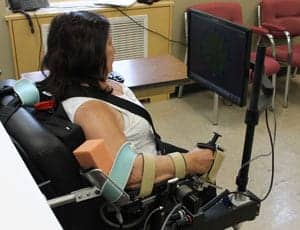
Two participants in the BrainGate clinical trial directly control a tablet computer through a brain-computer interface to chat with each other online. (Photo courtesy of BrainGate Collaboration)
Use of a brain-computer interface (BCI) enabled clinical trial participants with paralysis to communicate, chat and shop online, and use other tablet computer applications just by thinking about them.
The research, from the BrainGate consortium, was published recently in PLOS ONE.
Scientists, engineers and physicians from Brown University’s Carney Institute for Brain Science, the Providence Veterans Affairs Medical Center (PVAMC), Massachusetts General Hospital (MGH) and Stanford University participated in the collaboration.
The study included three participants with paralysis: two as the result of ALS, and one resulting from a spinal cord injury. Using the investigational BrainGate BCI, designed to record neural activity directly from a small sensor placed in the motor cortex, each participant was able to navigate through commonly used tablet programs, including email, chat, music-streaming and video-sharing apps. The participants messaged with family, friends, members of the research team, and their fellow participants. They surfed the web, checked the weather, and shopped online. One participant, a musician, played a snippet of Beethoven’s “Ode to Joy” on a digital piano interface, explains a media release from Brown University.
“For years, the BrainGate collaboration has been working to develop the neuroscience and neuroengineering know-how to enable people who have lost motor abilities to control external devices just by thinking about the movement of their own arm or hand,” says Dr Jaimie Henderson, a senior author of the paper and a Stanford University neurosurgeon. “In this study, we’ve harnessed that know-how to restore people’s ability to control the exact same everyday technologies they were using before the onset of their illnesses. It was wonderful to see the participants express themselves or just find a song they want to hear.”
The BrainGate BCI includes a baby aspirin-sized implant that detects the signals associated with intended movements produced in the brain’s motor cortex. Those signals are then decoded and routed to external devices. BrainGate researchers and other groups using similar technologies have shown that the device can enable people to move robotic arms or to regain control of their own limbs, despite having lost motor abilities from illness or injury.
In the study, neural signals from the BrainGate BCI were routed to a Bluetooth interface configured to work like a wireless mouse. The virtual mouse was then paired to an unmodified Google Nexus 9 tablet. The participants were then asked to perform a set of tasks designed to see how well they were able to navigate within a variety of commonly used apps, and move from app to app. The participants browsed through music selections on a streaming service, searched for videos on YouTube, scrolled through a news aggregator, and composed emails and chats.
Participants were able to make up to 22 point-and-click selections per minute while using a variety of apps. In text apps, the participants were able to type up to 30 effective characters per minute using standard email and text interfaces, the release continues.
The researchers were pleased to see how quickly the participants used the tablet interface to explore their hobbies and interests.
“It was great to see our participants make their way through the tasks we asked them to perform, but the most gratifying and fun part of the study was when they just did what they wanted to do—using the apps that they liked for shopping, watching videos or just chatting with friends,” says lead author Dr Paul Nuyujukian, a bioengineer at Stanford, in the release.
“One of the participants told us at the beginning of the trial that one of the things she really wanted to do was play music again. So to see her play on a digital keyboard was fantastic.”
The researchers suggest that the study could have the potential to open important new lines of communication between patients with severe neurological deficits and their health care providers.
“This has great potential for restoring reliable, rapid and rich communication for somebody with locked-in syndrome who is unable to speak,” states Jose Albites Sanabria, who performed this research as a graduate student in biomedical engineering at Brown University. “That not only could provide increased interaction with their family and friends, but can provide a conduit for more thoroughly describing ongoing health issues with caregivers.”
Senior author Dr Leigh Hochberg of Brown University, Massachusetts General Hospital and the Providence VA Medical Center sees tremendous potential for the restorative capabilities of BCIs exemplified in this study, the release notes.
“When I see somebody in the neuro-intensive care unit who has had an acute stroke and has lost the ability to move or communicate, I’d like to be able to say, ‘I’m very sorry this has happened, but we can restore your ability to use the technologies you were using before this happened, and you’ll be able to use them again tomorrow,’ ” Hochberg comments. “And we are getting closer to being able to tell someone who has been diagnosed with ALS, ‘Even while we continue to seek out a cure, you will never lose the ability to communicate.’ This work is a step toward those goals.”
[Source(s): Brown University, Science Daily]



